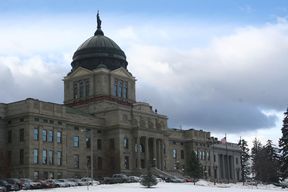
Many across the state are asking themselves that, especially in light of the terrible stream of bills that have come forth from the legislative body, as well as the rash of poor media attention coming our way nationally. To say that the Montana legislature has run amok would be an apt observation.
But was it always this way, or can we point to developments in our recent political past that point a clear picture to how today came to be?
I think so, and I'll show you by profiling sections of Governing Montana at the Grass Roots: Local Government Structure, Process and Politics, which was written by Ken Weaver. Weaver was a former mayor of Bozeman and former director of the Montana State University Local Government Center. Besides that he was chair of the MSU Political Science department for a number of years.
That wasn’t always the case, and the political lines weren’t always the same. The 1993 legislature had 53 Republicans in the House and 20 in the Senate. Yes, the GOP had the Montana House that year but the Democrats had the Montana Senate.
What happened since then?
Things went downhill for Democrats, that’s for sure. This is what Weaver had to say about it in Governing Montana at the Grass Roots:
“Since the 1994 legislative elections, this long standing pattern of essential equilibrium between the two political parties appears to have been dramatically altered. The 1995, 1997, 1999 and 2001 legislative sessions were dominated by substantial Republican majorities in both houses and the majority party enjoyed the relatively rare opportunity to govern in collaboration with a Republican governor through this period. It was the unanimous option of our “sample” of experienced participant-observers that this shift to the conservative side of the Montana political spectrum is not likely to be reversed in the foreseeable future.” (p 50-1)
These issues stem from the Montana Supreme Court’s 1998 decision to stick parties with an “open” system, which has led to a lot of chomping at the bit. Weaver saw this coming. He said forcing the parties to adhere to Montana’s “remarkably comprehensive ‘open meetings law’ will probably make establishment and enforcement of party discipline and cohesion even more difficult.”
Many felt that caucuses were “only marginally useful in establishing party cohesion” and that the real policymaking “generally took place in the offices of legislative leadership, especially the speaker’s office.” Weaver goes on to say that:
“the seasoned legislators of both parties in the sample of participant-observers asserted that the requisite consultation and nose-counting would simply take place in smaller, informal meetings conducted by legislative leadership beyond the scrutiny of outsiders.” (p 51)
“The expectation of the participant-observers was that the key leadership roles of both parties would, with the opening of the 2001 and 2003 legislative sessions, devolve upon much less experienced legislators who will have little institutional memory and who will have even greater difficulty influencing the voting behavior of their even more transient colleagues.” (p 51)
So…what’s correct – the same turnover we had in the legislature before term limits, or a higher level of turnover? Many liberal bloggers and Montana Democrats will have you believe that it’s higher, and that the level of competence of our legislators has gone down. What’s more, it’s often argued that the level of corporate influence and lobbying has increased since term limits went into effect, and even more so after they made their impact fully felt.
When you hear stories about legislators from Florida and Colorado trying to reduce our federal transfer payments as well as sell off our public lands, you begin to realize how the situation came about. Whether the 1992 voter initiatives and the backing for them was pushed by special interest groups opposed to Democracy is unknown. It could be Montana’s individualistic spirit, coupled with a large distrust of government that's giving us so much grief.
Weaver found that in 1994 just 28% of Montanans trusted their elected representatives to do their jobs. And why should the number be any higher? There’s always been a level of mistrust in Montana against the government, and much of it stems from private corporations’ control of that government. Anaconda Copper was a fine example, as historian K. Ross Toole highlights well in Twentieth-Century Montana when he profiles Montana politics in the 1920s:
“Although the approaches and devices of lobbying were varied, imaginative, and myriad, one of the standard methods employed (which was rendered enormously effective because of the Company’s almost total control of the press) was to introduce extraneous bills and then devise interminable debate and extensive press coverage of the same. This served three purposes: it confused the inexperienced legislator as to the proper priority of things; it enabled the press to attack or laud specific legislators (or the governor) on matters unrelated to anything that really mattered; it hoodwinked the public and covered the legislative scene with a cloud of obfuscatory verbiage.” (Toole, Twentieth-Century Montana p 260-1)
“a non-random sample of 20 of the most seasoned participant-observers of the Montana political scene sees little prospect for an early return to the structural equilibrium that characterized the state’s political system for nearly 50 years prior to 1994.” (p 49)
- The party caucus
- Governor
- Lobbyists
- Other legislators
- Grass roots input
- Direct corporate input
- State government agencies
- Legislative staff support
- Newspaper reports
- Newspaper editorials
- Television reports
- List other source
Weaver put those three in bold because they came in the most, and can be considered ‘first tier levels of influence.’ He goes on to say the following:
The response of this question is consistent with the perception of the respondents concerning the shift in policy leadership away from the executive branch and toward the legislative branch, thereby enlarging the potential influence of the 725 or so registered lobbyists. Indeed, the apparent enlargement to interest group influence during the 1995 and subsequent legislative sessions will probably be further expanded in the 2003 session when the full impact of term limits is felt in the senate. We anticipate that this event may require rethinking Montana’s hierarchy of legislative influence to acknowledge the resurgence of corporate interest groups in Montana, which appear to have become dominant at the outset of the twenty-first century.” (p 54)
- Montana Power Company
- Montana Mining Association
- Montana Stockgrowers Association
- Montana Taxpayers Association (corporate interests)
- Montana Chamber of Commerce
- Montana Tavern Owners Association (gambling interests)
Not included in that list because it’s a non-corporate/business was the Montana Education Association. Weaver mentions that the “legislative influence of labor, environmental interests and local government all lost ground.”
Those groups had the most power twenty years ago, and new corporate interests have risen up. They need to be studied, and it needs to be determined if they're harmful or helpful to the long-term interests and institutions of the state. What’s more, strengths and weaknesses need to be identified, regardless if they’re friend or foe.
What can be done about this long-term problem brought on by a unified, rightwing-funded plan to disrupt Montana? And what can be done to convince Montanans that they need to place more power in government to combat these corporate forces?
Weaver offers the following insight:
- Disrupt conservative control of the legislature by offering a fundamental tax reform initiative;
- Shift more power back to the governor’s office and away from the legislature, a body fractured by term limits as well as a lack of party cohesion and discipline;
- Invigorate an electorate to empower government rather than restrain it, giving state and local institutions the authority to address the critical policy issues present now in our second decade of the 21st-century.
Those are all ideas, and I encourage you to read Weaver’s book for more. I also encourage you to read other books about Montana history and politics so you can become a powerful tool in conversations. Thanks for reading!

